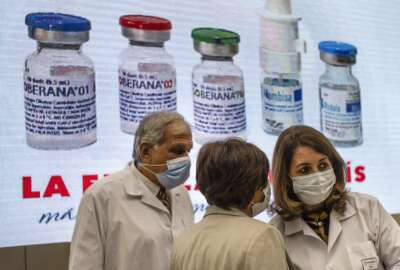
The Agriculture Department finds good use for millions of dollars to monitor animals and protect people
USDA wants to catch potential COVID-19 and other zoonotically originating diseases by keeping on top of animals susceptible to them.
Best listening experience is on Chrome, Firefox or Safari. Subscribe to Federal Drive’s daily audio interviews on Apple Podcasts or PodcastOne.
The Agriculture Department has a new initiative to conduct surveillance. It wants to catch potential Covid-19 and other zoonotically originating diseases by keeping on top of animals susceptible to them. It’s working on what officials call a strategic framework for an early warning system. For more, Federal Drive with Tom Temin talked to the associate administrator for USDA’s Animal and Plant Health Inspection Service, Dr. Michael Watson.
Interview transcript:
Tom Temin: Dr. Watson, good to have you on.
Michael Watson: Thank you very much, I really appreciate the opportunity to share the work that we’re doing.
Tom Temin: Alright, so a strategic framework for an early warning system. Tell us exactly what you’re looking at here.
Michael Watson: So the COVID-19 global pandemic has highlighted the risk of emerging and zoonotic diseases around the world. I think everybody’s aware of the challenges we’re facing. And scientists estimate that three out of every four new or emerging infectious diseases in people come from animals. And so our goal with this project is to conduct thorough surveillance of SARS-CoV-2 in susceptible animals by building an early warning system that will allow us to alert public health partners to take steps sooner to potentially prevent or limit the next zoonotic disease outbreak or the next global pandemic. And so, that’s our overall goal is to work with our public health partners and hopefully avoid another situation such as the SARS-CoV-2 has created around the world here.
Tom Temin: So is this basically a way of people that have animals, say that are inspected normally like farms, to have a reporting system that would then gather up all of the information, is that what you mean by surveillance?
Michael Watson: So the surveillance is going to be actually pretty broad scope. So we’re going to start as wide as possible. And we haven’t actually defined the specific effort. The framework gives an overall view and now we’re working on the details on how we’re going to go about doing that. But we want to start off with every possible animal species to see if they are susceptible SARS-CoV-2, and as we’re able to eliminate those ones that are not, we’ll be able to focus on those that are. So, it’s captive species, it’s pets, it’s wild animals as well. So we want to make sure we’re doing as a broader scope as possible to ensure that whenever there’s a possibility of a human-animal interaction, we have some sense of whether or not there’s potential for SARS-CoV-2 transmission, either from humans to animals, or vice versa.
Tom Temin: And what animals do we know are susceptible to this type of diseases, is it all of them or certain birds and what?
Michael Watson: So we don’t know for sure yet. And that’s a big part of our work we’re going to be doing here. We have had reports, and we have some data around mink that had been susceptible. We’ve had some data on animals such as lions and big cats. We have some recent data that showed that deer have the antibodies to the virus. And so we’re not really sure yet whether the deer are susceptible or just have been exposed, but we do know that deer carry the antibodies based upon the studies we’ve done so far. So, we do know there’s a number of animals that at the very least have been exposed, and showed indications of being exposed. And that’s why the biggest goal of this project is to figure out what that scope is. Again, starting as broad as possible, and just get an idea of which species are susceptible. Obviously this is going to take a little bit of time because we have to develop the ability to test these animals and ensure we have availability to those animals. But, the goal is identify that scope, and again, narrow down which ones are actually susceptible, and then we’ll go from there in terms of what those impacts are, what those species that are susceptible.
Tom Temin: We’re speaking with Dr. Michael Watson, the associate administrator for USDA’s Animal and Plant Health Inspection Service. And I’m guessing that at some point you’re going to have to enlist other federal agencies, the ones that look at places like deer and lions and mink, and so forth, because the APHIS doesn’t inspect anything beyond farm animals, if I have this correct.
Michael Watson: Actually, APHIS has already provided crucial support for SARS-CoV-2 testing in animals during the COVID-19 pandemic. And I mentioned before, confirming infections in mink as well as many other species. And so, our wildlife services unit actually does do testing in wildlife species. So that that’s part of their mission and our veterinary services unit does the work with captive species. And so, it is our mission to test wild and captive species. But as you mentioned, it does require a broader scope of work across the federal government and our partner. So, what we want to utilize is a one health approach. And a one health approach embraces the idea that the complex problems that affect health of humans, animals and the environment, are best solved during improved communication, cooperation, and collaboration across disciplines and sectors. And so we look to partner with those agencies working to protect animal health, public health and environmental health, including wildlife. And this will include at the federal level, CDC, Department of Interior, FDA, and other partners. This also includes work with tribal nations. At the state level, in addition to animal health partners, we look at state wildlife and public health agencies as well. So it’s kind of an all encompassing view. So it’s a public health part, animal health and wildlife health as well. So it’s all three components that we’re looking at.
Tom Temin: And in developing the framework then, that will lead to an operational plan for the surveillance to actually begin?
Michael Watson: Correct. So on August 24, we released to the public our strategic framework. And this gives an overall view of what we want to accomplish. And we’ve asked for the public — our stakeholders — to give us comments. The comment period’s open till October 8. Regulations.gov is where you can go to make comments. We want to make sure that we’re covering this broad scope that we need to, to ensure we have a good feel for which animals are susceptible. And we’ve given some ideas on some of the initial work that we’ll do. But as you mentioned, the goal will be for us to identify specific operational goals to address this issue in the various animal species that we’re talking about. So, the framework is broad in general, and we anticipated that this project is not a one or two-year project — this is gonna be a multi-year project. And as we go through these years, we will continue to develop this operational plans to start broadly, narrowed it down, and identify those species that are susceptible, and then figure out what that means — how they become susceptible, what it means once the animal is infected or exposed. Can an animal transmitted to other animals? Can an animal transmit to humans? And can humans transmit to that animal? So again, it’s a multi-pronged, multi-year effort. But again, the goal is to identify where that risk is in terms of the animal population so that we can in the future hope to prevent any transmission of SARS-CoV-2, any of the variants from SARS-CoV-2, and eventually, hopefully, this early warning system helps us with other zoonotic diseases in the future, again, to help prevent those future pandemics.
Tom Temin: And in your mind, do you imagine at some point, a type of visualization, a map showing species and instances of COVID that people could look up and kind of understand the trends in that way?
Michael Watson: Absolutely. We believe that one of the most critical parts of this work, and it’s in the framework, is the collaboration and communication part, right? So we want to make sure that the public, our public health partners, the agencies that support this work, are well aware of what those potential risks are, I’m using risk as for lack of a better word, but which animals present that risk so that we do the proper monitoring, we do the proper surveillance to ensure that we can again prevent that transmission from those animals to humans. So yes, absolutely. Communication and collaboration is a hugely critical part of this work.
Tom Temin: And by the way, do we know anything at this point about the susceptibility of other primates — apes and gorillas and orangutans and monkeys — to COVID?
Michael Watson: Yes, we have had some detections in zoos. I think there’s been some media reports around that. So, we do know that there has been, again, detection. But what that means, again, we’re not really sure. Does that means that the animal becomes infected and has some significant risk from the virus, or does that mean that the animal’s exposed and it creates antibodies to the virus? And so, that’s part of this work as well. So, first identifying which animals show positives for exposure, and then again, going in to see, does that mean the animals infected? If it’s infected, are there severe impacts or has the animal recover quickly? Those kind of things. We want to make sure that we’re able to have a really good feel to be able to tell the story about each animal species, what does sustainability is, and what the potential risk is for that species.
Tom Temin: And I’m also curious to know that, in say deer, which are eaten in some cases, or in just farm animals — livestock — does the presence of that COVID or the antibodies affect that particular animals or species ability to become food? In other words, can you eat a cow that might be infected once it’s slaughtered and cooked?
Michael Watson: There’s two questions there, actually. So one question is, are the workers who work with these infected animals at a higher risk of being infected by working with animals that have the virus, right? So that’s one thing we have to take into consideration and make sure that if we do have infected animals, that our partners — our one health workers — are protected from potential exposure to these animals. And then again, your second question is, is there potential for that transmission from those infected animals to humans through the food supply? And again, that goes into that issue of animals that show positive for SARS-CoV-2. What does that mean? Does it mean they’ve been exposed, does it mean they’ve been infected, and if they’re infected, as you mentioned, are they able to transmit that disease to humans, either through the food supply or other means kind of thing. So that’s a huge part of this as well to make sure that we have a good feel for what that potential transmission is from the animals to humans.
Tom Temin: So in the meantime, make sure those burgers are well done.
Michael Watson: Yeah, exactly. I think that’s really important. I mean I hate to say it, we don’t know enough yet to be able to answer the questions confidently that there is no risk. But again, we hope that we’re able to get to that point sometime in the near future so that we can make sure the American public knows what these risks are.
Tom Temin: Dr. Michael Watson is associate administrator for USDA’s Animal and Plant Health Inspection Service. Thanks so much for joining me.
Michael Watson: Thank you very much. I really appreciate the opportunity.
Copyright © 2025 Federal News Network. All rights reserved. This website is not intended for users located within the European Economic Area.
Tom Temin is host of the Federal Drive and has been providing insight on federal technology and management issues for more than 30 years.
Follow @tteminWFED





